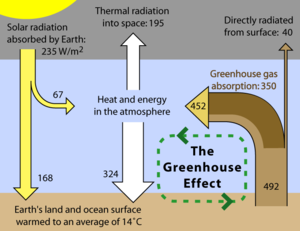
- Image via Wikipedia
The article reviewed today looks at how climate change concepts are described in textbooks used by high school students and teachers. It found a tendency to oversimplify or exaggerate many concepts, as well as to avoid the degree of inter-linkages between the various fields and forces at play. It concludes with three recommendations to make up for these deficiencies. The complexities of climate change science seem not unlike the links between vehicle emissions, level of pollution and impact on human health that are the focus of this blog. One aspect, in particular, is the apparent lack of communication and knowledge exchange between highway traffic engineers, air quality scientists and environmental health authorities, with the result that each of the three disciplines continue without the progress that might be expected if all were regarded as parts of the bigger problem – as well as in education of the public as addressed in this article.
Key Quotes:
“It is critical, therefore, that science textbook authors and publishers are aware of students’ common misconceptions about climate change when developing textbooks so that their works become effective tools for facilitating students’ conceptual development”
“The reviewed earth and environmental science textbooks did not adequately address students’ misconceptions about climate change, suggesting a need for revision.“
“Most of the reviewed studies reported that many held the misconception that the greenhouse effect is caused by a thin layer of dust or gases in the atmosphere“
“about half of the 18 scientific concepts of climate change were absent in the majority of the reviewed textbooks. Three of the textbooks neither distinguished among the types of radiation nor clarified how surface temperature is related to and distinct from infrared radiation“
“Six textbooks did not specifically mention that greenhouse gases are distributed in the atmosphere“
“Many students attributed global warming to an increase in incoming solar radiation, the Earth getting closer to the sun or the sun’s rays hitting more areas of the Earth”
“Recommendations:
*Clarification of scientific concepts of climate change.” Simple and familiar analogies and descriptions are pedagogically useful and appropriate for younger students; however, without careful clarification, these helpful analogies and simple explanations can hinder, rather than help, students’ conceptual development…
*Connecting and differentiating scientific concepts. Students’ misconceptions about climate change are often due to an inability to connect interrelated science concepts…..
*Presenting the nature of climate change science. Most of the reviewed texts described the impact of climate change in terms of global warming and did not address the likely variability of impacts on regional scales…”
Related articles by Zemanta
- Choo Choo Charley Runs Climate Science Off The Rails (riehlworldview.com)
- What a Fair Climate Change Debate Would Look Like (solarfeeds.com)
- A Quantitative Assessment of the Scientific Consensus on Anthropogenic Climate Change (wallstreetpit.com)
- UN Climate Panel Should Change Management, Study Says (businessweek.com)
- Credit Where It's Due: Attributing Weather Events to the People Responsible (ecosalon.com)
- "UN climate change panel to be warned over reports" and related posts (optimumpopulation.org)
- A Look at Geoengineering Strategies (solarfeeds.com)
- The Deepening Crisis (scientificamerican.com)
- A lesson for NZ critics of climate science? (openparachute.wordpress.com)
- Study Finds No Link Tying Disaster Losses to Human-Driven Warming (dotearth.blogs.nytimes.com)

No comments:
Post a Comment